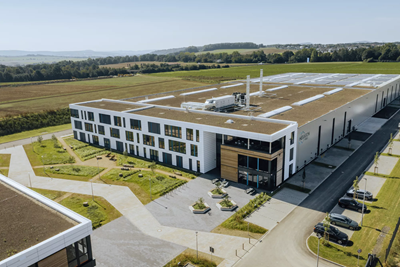COPVs designed, qualified for demanding aerospace, automotive applications
CAMX 2024: Hexagon Purus showcases its portfolio of Type 3 and 4 COPVs which can be configured to meet a variety of needs.
Share
Hexagon Purus (Oslo, Norway) is displaying its broad portfolio of composite-overwrapped pressure vessels (COPVs). The primary focus is on its Type 3 (metallic liner) and Type 4 (plastic liner) COPVs developed and qualified for the aerospace and automotive industries. Hexagon Purus’ team is available at the booth to discuss its solutions.
These cylinders are said to be lightweight, cost-effective and reliable. The company offers propellant and pressurant tanks up to 10,000 psi operating pressure and 1,000 L water volumes in a variety of mounting configurations. Custom designs are possible or an existing design can be tailored to meet the customer’s specific requirements. Cylinders can be certified to industry standards such as AIAA S-081 or G-082 or to customer-specific requirements.
Hexagon Purus’ Type 4 cylinders are designed to present several advantages in modern aerospace applications including rapid development cycles, reduced weight and fatigue resistance. They can be used in many pressurant applications and with krypton and xenon in electric ion propulsion systems. The cylinders have completed rigorous qualification test programs and have met vibration, static loading, thermal, damage tolerance, lifecycle and rupture test requirements.
Also featured are the company’s Type 4 hydrogen mobility cylinders and storage systems, which are commonly used in fuel cell electric buses and heavy-duty trucks. Cylinders operating at 350 and 700 bar are typical with hydrogen capacities up to 18 kg. Storage systems can be offered in roof mount, behind-the-cab (BTC) or sidemount configurations with capacities up to 74 kg. These systems can be supplied with the necessary refueling receptacle, filtration, regulator, high- and low-pressure gages, relief valves and controller for a completely integrated solution.
Related Content
-
Honda begins production of 2025 CR-V e:FCEV with Type 4 hydrogen tanks in U.S.
Model includes new technologies produced at Performance Manufacturing Center (PMC) in Marysville, Ohio, which is part of Honda hydrogen business strategy that includes Class 8 trucks.
-
Infinite Composites: Type V tanks for space, hydrogen, automotive and more
After a decade of proving its linerless, weight-saving composite tanks with NASA and more than 30 aerospace companies, this CryoSphere pioneer is scaling for growth in commercial space and sustainable transportation on Earth.
-
Midnight production aircraft completes full transition flight
This is Archer’s second full-scale eVTOL aircraft to achieve this milestone, critical to being able to carry commercially viable passenger payloads.
Related Content
Honda begins production of 2025 CR-V e:FCEV with Type 4 hydrogen tanks in U.S.
Model includes new technologies produced at Performance Manufacturing Center (PMC) in Marysville, Ohio, which is part of Honda hydrogen business strategy that includes Class 8 trucks.
Read MoreInfinite Composites: Type V tanks for space, hydrogen, automotive and more
After a decade of proving its linerless, weight-saving composite tanks with NASA and more than 30 aerospace companies, this CryoSphere pioneer is scaling for growth in commercial space and sustainable transportation on Earth.
Read MoreMidnight production aircraft completes full transition flight
This is Archer’s second full-scale eVTOL aircraft to achieve this milestone, critical to being able to carry commercially viable passenger payloads.
Read MoreHexagon Purus opens new U.S. facility to manufacture composite hydrogen tanks
CW attends the opening of Westminster, Maryland, site and shares the company’s history, vision and leading role in H2 storage systems.
Read MoreRead Next
Hexagon Composites initiates Hexagon Purus spin-off and private placement
Hexagon considers the intended separation as an important step for strengthening both Hexagon’s g-mobility and e-mobility (Hexagon Purus) businesses.
Read MoreHexagon Purus opens new composite H2 cylinder manufacturing hub in Kassel, Germany
Third new manufacturing facility for Hexagon Purus this year and second dedicated to carbon fiber-reinforced composite pressure vessels for H2 storage.
Read MoreHexagon Purus announces new manufacturing facility for composite battery packs, hydrogen fuel storage systems
The Hexagon Group spin-off has broken ground on the 60,000-square-foot micro-factory, based in Kelowna, Canada, which is scheduled for 2022 completion.
Read More









